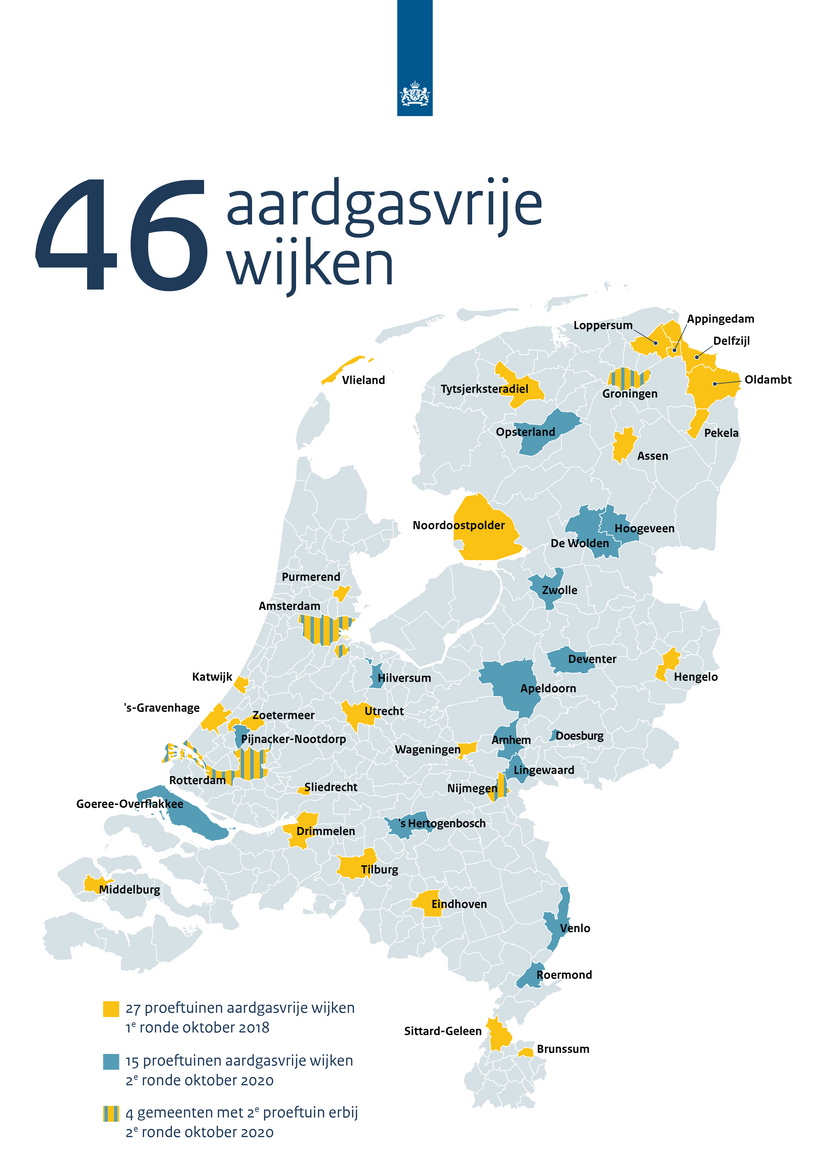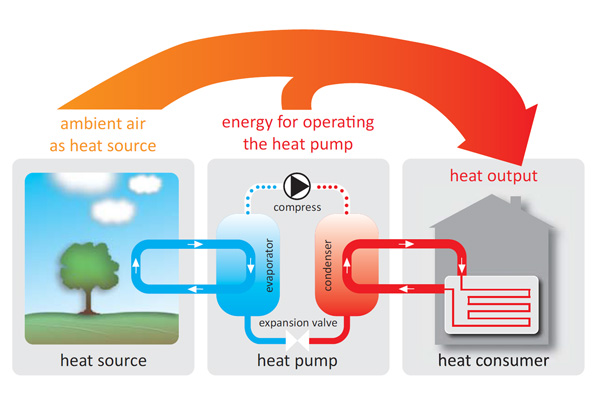Sustainable Households

Towards natural gas-free households
Currently, almost all Dutch houses, companies, schools, hospitals and other buildings use natural gas. This is responsable for a large amount of national CO₂ emission. The Natural Gas-Free Neighborhoods Program known in Dutch as Programma Aardgasvrije Wijken (PAW)1 is set up to learn how homes and other buildings can become free of gas by 2050. The country is switching from natural gas to sustainable energy sources such as sun, wind and water. There are 46 municipalities2 in the Netherlands that participate in the PAW to make homes and other buildings natural gas-free or ready to become natural gas-free at a later date.

In 2021, the government will choose more neighborhoods to be part of the program. The government chooses neighborhoods that can reduce a lot of CO₂ emissions. By 2050, nearly 7 million households and 1 million buildings must be gas-free. In the period up to and including 2030, the Climate Agreement agreed to make 1.5 million homes and other buildings more sustainable. Besides the PAW, other measures have been taken to achieve the goals of the Climate Agreement. One of those measurements is that since 2018 new homes must be natural gas-free. With the Warmtefonds, subsidies en fiscale regelingen, there are more financial opportunities for homeowners to make their homes more sustainable. For example, there are subsidies to help owners of rental properties (e.g. housing corporations and owners’ associations) to make homes more sustainable.
The ways in which this transition to natural gas-free living is being made include the following:
- Good insulation
- Sustainable installations for heating and hot water
- Use of sustainable energy sources
Regarding good insulation, there are plenty of ways in which this can be achieved: roof insulation, floor insulation, cavity wall insulation, as well as HR++ or triple glass. Houses built since 2000 have good to very good insulation of the roof, floor and facade and use HR++ or triple glass3. Further improvement on insulation will not have the same effect anymore. Therefore, other ways to make houses more sustainable and energy efficient have to be found. One example is the use of a heat pump or district heating (Warmtenet). Another example is the use of solar panels.
Low temperature heating

Most houses in the Netherlands still have a central heating boiler and radiators. The central heating boiler heats the water that goes to the radiators to about 70 to 80 °C. This high water temperature is required in houses that are not well insulated to keep the house warm during cold days. For well-insulated houses, keeping the water temperature at about 35 to 55 °C (i.e. temperature that a heat pump supplies) is enough to keep the house warm. When the heating (climate system) is able to provide sufficient heat with water at those temperatures it is called low temperature heating. If a house demands only low temperature heating (thanks to its insulation) then the number of technologies that can provide this heat increases. It is then for example also possible to use heat pumps. Heat pumps wouldn’t have been sufficient if high temperatures are required. Hence, low temperature heating expands the possibilities for natural gas-free households.
Heat pump
A heat pump provides heating and hot water in a sustainable way. Heat pumps make smart use of the heat in the air, soil, or groundwater and turn it into a usable temperature. From 1 kWh of electricity, a heat pump produces 2 to 5 kWh of heat. More than 280,000 houses in the Netherlands (2018) already have a heat pump4. There are 3 types of heat pumps:
- Full electric heat pump: provides heating + hot water in the bathroom and kitchen, which means a boiler is no longer needed.
- Hybrid heat pump: works together with a central heating boiler. It provides heating on most of the days. The boiler only jumps in when it is very cold and when hot water in the bathroom and kitchen is needed.
- Ventilation heat pump: It works together with a mechanical ventilation system by extracting heat from the ventilation air.
The Coefficient of Performance (COP) expresses how efficiently a heat pump uses energy. Because the efficiency is always different due to, for example, the outside temperature, the use and the home in which it is located, the Seasonal Coefficient of Performance (SCOP) is often used. A COP of 4.0 means that a heat pump supplies 4 times as much heat as it uses electrical energy. In this case, 1 kWh of electricity therefore produces 4 kWh of heat, in other words, a heat pump has an efficiency of 400%.
How could Crownstone help even further?
The role of Crownstone in this journey towards sustainability is to contribute to energy-neutral living by ensuring that the energy is being used only when it is needed. Besides helping to reduce the potential waste in electricity usage (by reducing around 10% of standby power5, around 5% by providing insight in energy usage, etc.), Crownstone hardware can also reduce the energy consumption of a heat pump. To provide an estimate of how much energy can be saved by using Crownstones together with a heat pump, the following data is considered:
| Household usage (2020) | Per year6 | Costs (€/unit) | Costs (€) |
|---|---|---|---|
| Electricity | 2832 kWh | 0.2203 | 623.89 |
| Gas | 1340 m3 | 0.7868 | 1054.31 |
On average, 80% of the gas is used for heating and 20% for hot water6, mainly showering. Let us only consider heating and assume hot water is still provided by a hybrid pump or electric boiler. Given the statistics above, Dutch household uses on average 1072 m3 gas for heating (excluding hot water). Let us assume 1m3 of natural gas yields 35.17 MJ. This means that 9.76 kWh of heat is released. For a boiler with an efficiency of 95% this becomes 9.27 kWh of useful heat. If we use this factor to calculate the equivalent electricity budget for 1072 m3 of natural gas, we would require 9939.6 kWh for heating. If this heat has to be supplied by an electric heat pump with a COP of 4 it requires 2484.9 kWh. This is € 547.42 in annual costs for heating.
Crownstone can reduce these costs by using absence detection to adjust the heating in a household. No heating when no one is present adds up7 to 16%, which in terms of savings represents € 87.59 per year.
There are also other factors to take into account when trying to reduce the energy consumption with low temperature heating. For example, when living in a house where the temperature drops quickly due to poor insulation, turning off the heat pump at night is a bad idea. The money saved by turning off the heat pump for 7-8 hours at night will most likely be lost when warming up the house again from such a low temperature. When a house is well insulated, it is possible to set the thermostat to turn off or activate the heat pump after a certain time. This way, the heat pump won’t have to work too hard to restore warmth. Of course, the perfect combination to make low temperature heating even more efficient will depend on different factors: (1) the quality of the heat pump, (2) the capacity of the pump, (3) good SCOP/COP values, (4) fit for the local climate, (5) insulation of the home, (6) a smart thermostat, (7) presence/absence detection, and (8) zone-based control. Crownstone can make sure no energy is being wasted. For example, the heating can be adjusted when no one is in a specific room. Each household might have different needs depending on the routine of the people living there. Maybe some of them have constant schedules throughout the week or maybe some others have varying schedules. The situations might differ, but for every of them having a device that can help to turn off the heating when not being used is always convenient, especially when it translates to monetary savings per year and reduction of the CO2 emissions.
References
- Rijksoverheid: https://www.rijksoverheid.nl/onderwerpen/aardgasvrije-wijken/bestaande-gebouwen-aardgasvrij-maken
- Rijksoverheid: https://www.rijksoverheid.nl/onderwerpen/aardgasvrije-wijken/deelnemende-gemeenten-aardgasvrij-maken
- “Alles over isoleren” by Milieu Centraal
- “Warmtepomp: duurzaam elektrisch verwarmen” by Milieu Centraal
- Milieu Centraal en CBS (berekening Nibud, 2020)
- “Gemiddeld energieverbruik” by Milieu Centraal
- “Besparen met slimme thermostaat” by Milieu Centraal
Footnotes
A technical footnote (they are not important for the story). Some heat pumps can be also used for cooling. In this case another indicator is used: Energy Efficiency Ratio (EER). An EER of 4 means that a heat pump uses 1 kWh of electrical energy to remove 4 kWh of heat from a house. In this case, the Crownstone might also have a possibility to reduce the energy consumption of these devices.
24 February 2021

Show Comments
(not shown automatically to support your privacy)